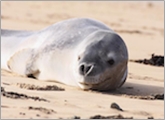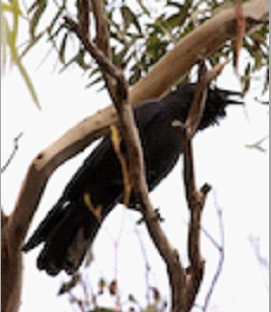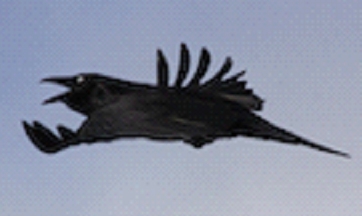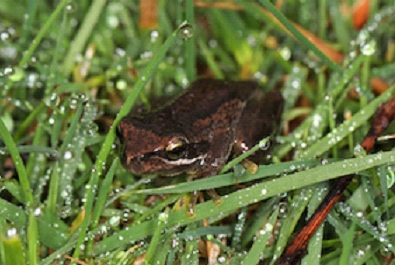Following on from last month’s report on the male Fur Seal visiting Point Roadknight, this month we have seen two subadult Leopard Seals visiting our beaches, one at Point Addis and the other at the Anglesea river mouth.
 Seal
Seal
Both were carrying injuries and were not at full weight. Parks and the Melbourne Zoo were notified of these visitors, and the beaches monitored to keep dogs and spectators away so they could hopefully recover. After several days of lying around on the beaches both seals ventured back into the ocean.

Over the last month there have been numerous sightings of Southern Right Whales slowly moving along the coastline heading east. They have been observed off Torquay Beach, Aireys and Lorne with numerous sightings recorded.
During recent weeding outings behind Urquhart Bluff, Margaret MacDonald and Kaye Traynor recognised a slightly different call to the common Little Raven, Corvus mellori. On closer observation they identified the birds as the Large Australian Ravens, Corvus coronoides, which are more often seen in land and north of Geelong. They can be distinguished by their more prominent throat hackles.
 Australian Raven (note throat hackles)
Australian Raven (note throat hackles)
The Little Ravens had been seen buzzing around the Leopard Seal as it lay still on the beach. Perhaps they had noticed the large cut on its hind flipper that was attracting flies, appealing to the raven’s carrion feeding nature. In the picture you can notice it does not have throat hackles.
 Little Raven (without hackles)
Little Raven (without hackles)
Two separate groups of Sooty Oystercatchers, Haematopus fuliginosus, (10 birds altogether) were photographed on the beach at Aireys Inlet by Margaret Lacey.
 Sooty Oystercatchers
Sooty Oystercatchers
A Swamp Antechinus was also recently found, deceased, on the coastal walk at Aireys Inlet. Male antechinus die soon after they mate.
The recent abundant flowering of the Ironbarks down along the Ironbark Gorge, was the scene of much loud and raucous activity with numerous species of Honeyeaters. The ground was awash with flowers and the chorus from above very loud with hundreds of birds visiting including Red Wattle Birds, Brown-headed, White-naped, White-eared, Crescent and New Holland Honeyeaters, with numerous Eastern Spinebills, and the full range of Thornbills. In the background one could also hear the Sulphur-crested Cockatoos and Crimson Rosellas.
With the much-needed rains this winter we have had our regular frogs come out wherever a small wetland puddle appears, hopefully to spawn and raise their tadpoles before it all dries up. Below are a few recent photographs taken by Jordan Ayton at the Bellbrae Reserve, including the Brown Tree Frog, Litoria ewingii, and the Common Eastern Froglet, Crinia signifera.
 Brown Tree Frog
Brown Tree Frog
 Common Eastern Froglet
Common Eastern Froglet
Pobblebonks or Eastern Banjo Frog, Limnodynastes dumerilii, have been heard around local ponds coming up from their underground burrows once they sense the moist soil.
 Eastern Banjo Frog
Eastern Banjo Frog
The Spotted Grass Frog, Limnodynastes tasmaniensis, was also seen.
John Lenagan